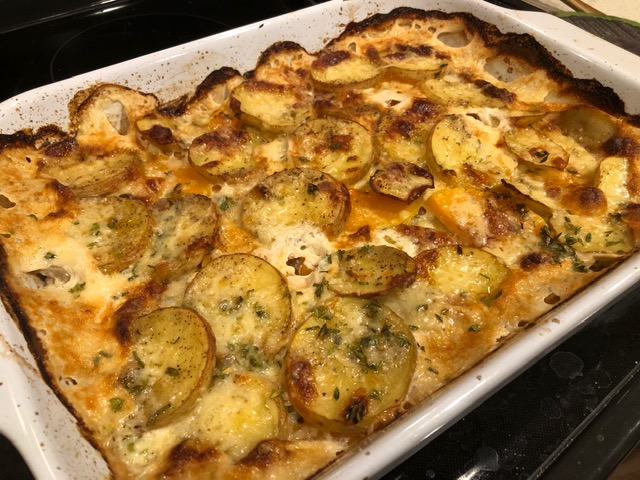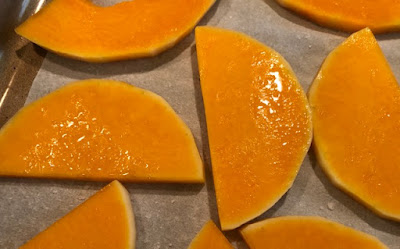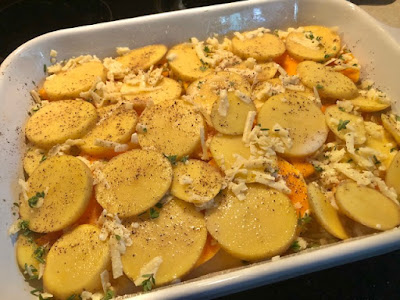
Recipe: Gratin remade is healthier than most

|
Potato gratins are popular side dishes, especially as the weather cools. But most gratins are so loaded with cream, butter and cheese that they could qualify for the "heart attack on a plate" label that is firmly attached to such dishes as fettucine alfredo. Not going there, thanks.
Looking for something new to do with the best of the winter squash -- butternut, of course -- I found a gratin recipe that uses half squash, half Yukon Gold potatoes, milk instead of cream, no butter, and just 4 ounces of cheese. Hmmm, this had potential.
The one caveat: Almost everyone who had tried this New York Times recipe said it had way too much liquid in it, and it took too long to cook.
OK, I thought, that's a good challenge: Let's remake this recipe so that's it's workable and flavorful without being a soupy mess.
My plan of attack: One, I salted the vegetables before cooking, to draw out the extra water. This especially worked with the Yukon Gold potatoes. (Note, don't use russets as a substitute; they have different cooking times.) Two, I reduced the amount of liquid in the recipe. Three, I spread the vegetables out in a larger baking pan than I would have used normally. Four, I turned up the heat a bit.
The result: A delicious, cheesy, crunchy top layer, perfectly cooked veggies, and just a little bit of extra liquid in the bottom of the dish. Use a slotted spoon to serve and you can avoid having it pool on the dinner plates.

|
Butternut squash and potato gratin
Serves 4-6
Ingredients:
1-1/2 pounds of Yukon Gold potatoes, scrubbed but unpeeled
1-1/2 pound piece of butternut squash (I used half of a 3-pound squash)
Kosher salt
Olive oil
2 cloves garlic
4 ounces Gruyère cheese, shredded, divided
1 teaspoon or more fresh thyme leaves
1/2 teaspoon fresh rosemary leaves, minced, optional
Freshly ground black pepper
2 cups low-fat milk

|
Instructions:
Cover two rimmed baking sheets with parchment paper and set aside.
Slice the potatoes into 1/4-inch rounds and spread them across one of the pans. Peel and seed the butternut squash, cut it into 1/4-inch half-round pieces, and spread those across the other pan.
Sprinkle each pan with 1/4 teaspoon of the kosher salt, and set the pans aside for 15 minutes to draw out the liquid from the vegetables.
Preheat oven to 400 degrees. Prepare a large rimmed baking dish; I used a ceramic 10-by-13-inch roasting pan. If desired, cut one of the garlic cloves in half and rub the halves around the edges of the dish. Then, whether you used the garlic or not, grease the dish bottom and sides with a light coating of olive oil.
Mince the other garlic clove and anything remaining from the cut one; set aside. Combine the thyme and the rosemary (if using) in a small bowl with some ground black pepper.
When 15 minutes are up, blot the liquid as much as possible from the potato and squash slices, using a clean kitchen cloth or thick paper towels.
Layer half the squash slices across the bottom of the pan, as evenly as possible. Then layer half the potato slices over the squash. Sprinkle the vegetables with half the garlic, about 1/3 of the herbs, and 1/4 packed cup of the cheese.
Repeat the layers, starting with squash and ending with 1/4 cup of cheese. You should have about 1/2 cup (or more) of cheese remaining and just a bit of the herbs; set those aside for now.
Carefully pour all the milk around the vegetables (easiest from the edge). Grind some more black pepper over the top of the casserole, sprinkle on just a pinch more salt, and slide the dish into the oven. Bake for 40 minutes; the cheese and potatoes should just be starting to brown by then.

|
Sprinkle the remaining cheese and herbs over the top of the dish, and continue baking until everything is brown, crunchy and bubbling, at least 10 more minutes. (Double-check that the vegetables are tender by sticking the tip of a sharp knife into a couple of the potatoes.)
Remove the pan to a cooling rack and let it rest at least 10 minutes before serving.
This gratin can be made ahead and reheated.
Comments
0 comments have been posted.Sacramento Digs Gardening to your inbox.
Sites We Like
Garden Checklist for week of Oct. 27
It's still great weather for gardening. Grab a sweater – and an umbrella, just in case – then get to work:
* October is the best month to plant trees, shrubs and perennials.
* Harvest pumpkins and winter squash.
* Pick apples and persimmons. Remember to pick up fallen fruit, too; it attracts pests.
* Clean up the summer vegetable garden and compost disease-free foliage.
* Dig up corms and tubers of gladioli, dahlias and tuberous begonias after the foliage dies. Clean and store in a cool, dry place.
* Treat azaleas, gardenias and camellias with chelated iron if leaves are yellowing between the veins.
* Now is the time to plant seeds for many flowers directly into the garden, including cornflower, nasturtium, nigella, poppy, portulaca, sweet pea and stock.
* Plant seeds for radishes, bok choy, mustard, spinach and peas.
* Plant garlic and onions.
* Set out cool-weather bedding plants, including calendula, pansy, snapdragon, primrose and viola.
* Reseed and feed the lawn. Work on bare spots.